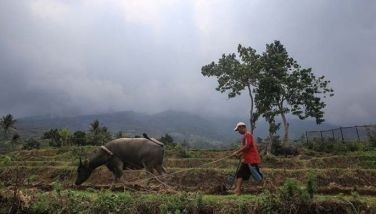12 M Pinoys at risk from killer ‘bulate’

Twelve million Filipinos are at risk from schistosomiasis while 6.8 million are already exposed to the so-called snail fever, which is endemic to 12 regions and 28 provinces in the country. File
MANILA, Philippines - Twelve million Filipinos are at risk from schistosomiasis while 6.8 million are already exposed to the so-called snail fever, which is endemic to 12 regions and 28 provinces in the country.
Schistosomiasis is a parasitic disease that silently takes away people’s lives in poor areas. Aside from the Philippines, snail fever is also endemic in China and Indonesia.
The highest prevalence of infection in the country is among those aged five to 15. But even adults are not spared. The mortality rate is 1.8 percent among untreated patients.
According to Dr. Vicente Belizario, convenor of Neglected Tropical Diseases Study Group under the University of the Philippines-College of Public Health, and the World Health Organization, people contract the disease when larval forms of the parasite – released by freshwater snails – penetrate the skin during contact with infested water.
Transmission occurs when people suffering from schistosomiasis contaminate freshwater sources with their excreta containing parasite eggs, which hatch in water, the WHO said.
In the Philippines, among the reservoirs of infection and environmental contamination are humans, cows, dogs, pigs, carabaos, field rats and monkeys because of open defecation especially in the rural areas.
“The cases start when, for example, a carabao (defecates in a body of water) and then the farmers, children (pass through, take a bath or swim there) or the mothers wash clothes,” Belizario said.
In the body, the larvae develop into adult schistosomes, the WHO fact sheet as of January of this year showed. Adult worms live in the blood vessels where the females release eggs. Some of the eggs are passed out of the body in the feces or urine to continue the parasite’s lifecycle. Others become trapped in body tissues, causing immune reactions and progressive damage to organs, particularly the liver.
Lack of hygiene and certain play habits of school-age children such as swimming or fishing in infested water make them especially vulnerable to infection, the WHO said.
Considered a neglected tropical disease, schistosomiasis mostly affects poor and rural communities, particularly agricultural and fishing populations, the WHO added.
“The Philippines is quite popular for worms. Why? Because the Philippines has the most number of (schistosomiasis) globally, believe it or not. But why are we not talking about it?” Belizario asked.
“That’s because first, the problem is only prevalent in poor provinces and not national in scope; second, it’s a poor man’s disease and it doesn’t hit the headlines,” he said.
Belizario said information from the WHO and scientific journals would confirm the seriousness of the problem in the country.
The WHO said based on estimates, 218 million people required preventive treatment for schistosomiasis worldwide while more than 66.5 million people were reported to have been treated for the disease in 2015.
Belizario said the disease affects the “bottom billion” of the world’s population and those with swollen bellies as seen in photographs of people with schistosomiasis retain abdominal fluid because the worms had damaged their liver.
Overt symptoms of schistosomiasis are presence of blood in the feces, anemia, chronic pain or fatigue while the subtle ones include
stunted growth, impeded school or work performance or increased susceptibility to other diseases, Belizario said.
In the case of soil-transmitted helminthiasis (STH) or infection caused by different types of parasites (known in the country as bulate), Belizario explained the stomach would bulge because of worms the size of spaghetti strands.
War on worms
Belizario said there are 3Ps involved in the fight against worms: people, poverty and parasites.
Among children, he noted that they become short, thin and perform poorly in school. “That’s proven by the experts. In other words, malnutrition. That includes poor cognitive performance,” Belizario said.
“Even if you don’t die, (it’s still a problem) if you have parasite infection,” he said.
In Agusan del Sur, “we looked into one barangay and (found) that 70 percent of the children have schisto,” Belizario disclosed, noting the prevalence rate in the province was at 32 percent among elementary and high school students based on recent statistics.
“In Negros Occidental, we saw a child (with schistosomiasis) who passed away two or three weeks after. It was too late… the liver was already damaged severely. No matter how good the doctor is, no matter how good medication is, that’s not going to work anymore. It’s sad,” Belizario lamented.
But there is no reason to be hopeless. Belizario and the WHO said schistosomiasis control focuses on reducing disease through periodic, large-scale population treatment with praziquantel, the medication used to treat a number of types of parasitic worm infections.
The drug is available for free at the Department of Health but the problem lies in its effective administration. For one, local health management is decentralized and it will be up to local government units to adopt their own system to deal with the problem.
When he was DOH undersecretary during the past administration, Belizario said they tapped the teachers to administer the medication for common worm infections among young students all over the country and in one day, 12 million children were covered.
The program was called National Deworming Day or Goodbye Bulate but he said not much focus was given on schistosomiasis cases.
“Our stance is not to put DOH in shame, but rather to highlight these concerns and help provide solutions,” Belizario said.
He said mass drug administration or “pagpupurga” could be done
once a year or every January for schistosomiasis cases and twice a year – every January and July – for soil-transmitted helminthiasis (STH) or infection caused by different types of worms (locally known as bulate).
There must be consistency in implementing programs for deworming, Belizario stressed, as the parasites could go back after three months because “children play and they get dirty, they do not wash their hands and some do not have toilets.”
In affected areas, Belizario said those who pass through flooded streets with water coming from infested rivers or creeks could also be infected.
Belizario recounted an incident wherein a teacher died because of lack of treatment from schistosomiasis even if people were saying she had the disease.
“The children, we can save them early. We can prolong the life span of these children,” he emphasized.
Through mass drug administration, Belizario said everyone from ages five to 65 would be treated.
“That’s a national policy by DOH and is also followed on a global scale. We do not need diagnostic tests anymore since it’s proven that the areas have worsening situation. It’s better to treat everybody than to catch each and everyone to undergo diagnostic tests. This is why we have mass deworming for ages one to 18,” Belizario said.
The WHO said a more comprehensive approach includes the supply of potable water, adequate sanitation and snail control.
Belizario said open defecation among humans and animals must be stopped as snail control could sometimes destroy the bodies of water in the process because of the chemicals used. For the LGUs, the standards for cleanliness for the environment and bodies of water in particular apparently do not include being free from snail infestation and the health condition of people.
There are other tropical diseases in the country that are also not yet prominent in the consciousness of the public.
“The DOH alone (cannot) solve this. Why? DOH does not champion animals. They don’t champion improving sanitation in the communities where people openly defecate,” Belizario said.
“Two percent of those infected die. Should they perish? No. The drug is free. As long as the treatment is done properly and at the right time, we can reach a point of no return,” he said.
Belizario believes a direct order from President Duterte will push the health department to deal with the disease.
“My reflection is this: what if there is no research? (What about) the places that are not reached? Our research does not cover the whole of the Philippines…People are reported to be dying. Is (the situation) being reversed? There’s a need for us to raise awareness. We should improve the program to avoid deaths,” he said.
Before, the problem is lack of funds to buy medicine but Belizario pointed out these are now available.
“The government now buys all the medicines we need, the problem is how to administer them). It will be (a) life-saving (undertaking) every year,” he said in Filipino.
“The medication is effective... 99.99 percent of the time, the worms are flushed out. So, keep the streams free from human feces, respect the presence of the snails,” he said.
In all health services in endemic areas, Belizario said the goal was to attain a minimum target of regular administration of the medication to at least 75 percent of the population and up to 100 percent of all school-age children at risk of morbidity by 2010.
“We did not reach this target,” he said.
- Latest
- Trending
































